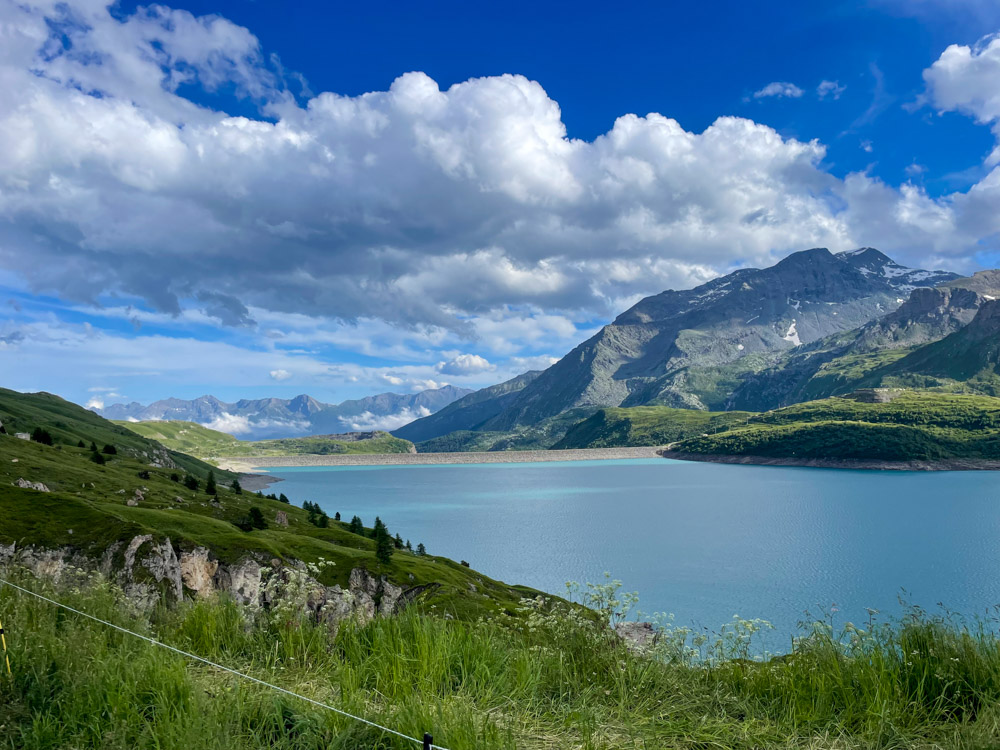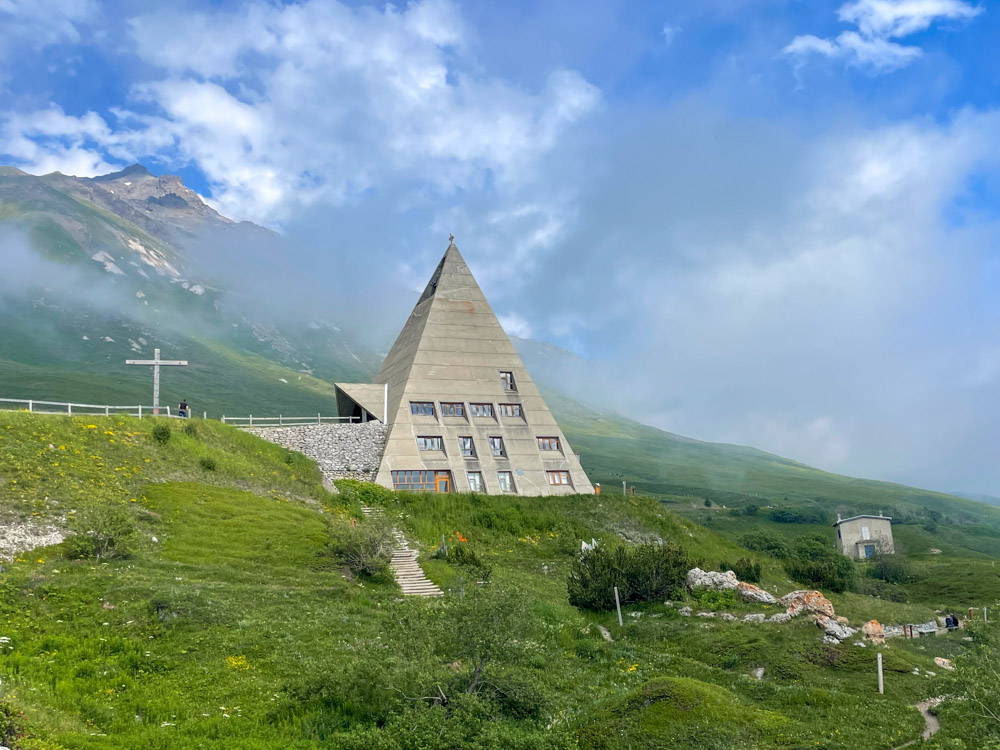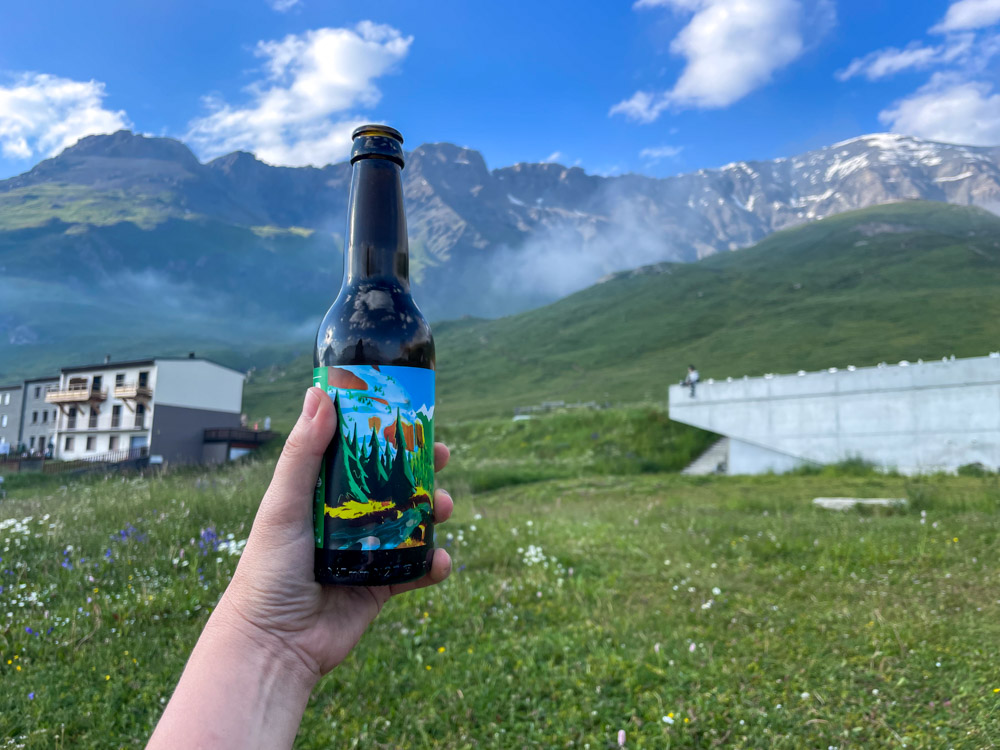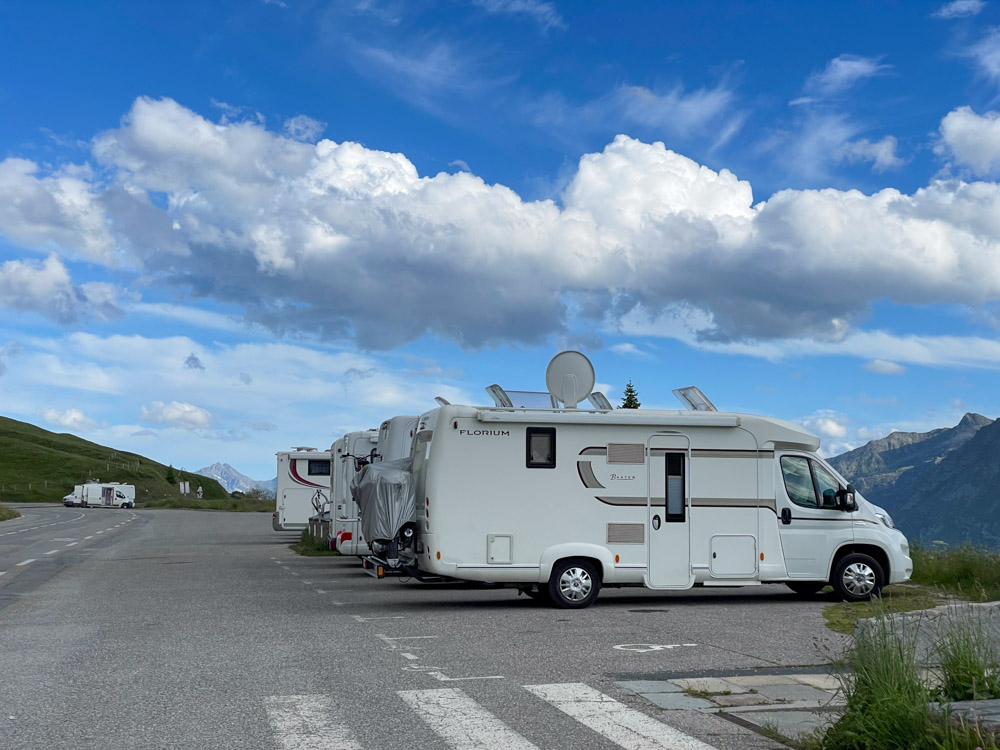Nestled among majestic mountains and shaped by an impressive dam, Mont-Cenis Lake is an ideal escape from city life. Located less than 100 km from Turin, Italy, and just 60 km from Saint-Jean-de-Maurienne, France, this stunning alpine lake is easily accessible via a convenient main road. You can visit for relaxing day trip or a longer motorhome adventure and it’s perfect to immerse yourself in nature and history.
Table of Contents
Where is Mont-Cenis Lake?
Mont-Cenis Lake is located in the heart of the Alps, on the border between France and Italy, within the Mont Cenis Pass. Officially on French territory, it lies in the Savoie region, but it’s historically and culturally connected to Italy’s Piedmont region.
PLAN YOUR TRIP TO FRANCE
Stay connected with a Holafly eSIM during your trip to France and enjoy unlimited data, with fast reliable internet and no roaming charges.
Get Heymondo travel insurance to travel carefree and enjoy every moment of your adventure.
The lake is 1,974 metres high and can be reached from the Italian side via Susa or the French side via Modane and Lanslebourg. This strategic location has made the Mont Cenis Pass a vital transit route since ancient times. In fact, it links the Po Valley with the Rhône-Alpes region of France.
A Brief History of Mont Cenis and Its Alpine Pass
The Mont Cenis Pass has played a key role in European history for centuries. It served as one of the most important transalpine routes between Italy and France. Used since Roman times, it became a major military and commercial corridor throughout the Middle Ages and into the modern era.
Napoleon Bonaparte famously improved the road in the early 19th century to facilitate troop movements and trade, turning it into one of the first modern alpine highways.
In the late 1800s, the Mont Cenis Fell Railway operated briefly across the pass before the opening of the longer, safer Fréjus Rail Tunnel. During both World Wars, the pass regained strategic importance, and several military fortifications were built in the surrounding mountains.
Today, although the pass no longer serves as a major transport route due to the development of tunnels, it remains a place rich in history. You can still explore the remnants of forts and historic paths that once connected nations and empires across the Alps.
What to Do at Mont-Cenis Lake
Set among the majestic Alps, Mont Cenis offers a wide range of outdoor activities. You can explore hiking trails around the dam and visit ancient fortifications with easy walks suitable for all levels. The lake is also a popular spot for fishing, although swimming is not allowed for safety reasons.
I’ve been there many times, both on day trips by car and overnight stays in a motorhome. It’s the perfect place to unwind and reconnect with nature, breathing in the fresh mountain air. And if you love local food, don’t miss the chance to taste delicious Alpine cheeses. Beaufort and Bleu are typical of the region.
Admire the Impressive Mont Cenis Dam
The Mont-Cenis Lake is a remarkable destination. Located on the Mont Cenis Pass at an altitude of 1,974 metres, it is an artificial reservoir holding 320 million cubic metres of water. A dam built between 1962 and 1968 supplied hydroelectric power to the ENEL plants in Venaus (Italy) and EDF in Villarodin-Bourget (France).
However, this valuable resource for the region also had a significant environmental and social impact. Its construction led to the destruction of Alpine pastures and the complete submersion of a village and a small mountain lake once located in the valley.
Despite this, Mont-Cenis Lake remains a fascinating and evocative place to visit. Its natural beauty, breathtaking views, and historical and energy significance make it a must-see destination for anyone who loves outdoor travel.

Discover the Unique Beauty of the Pyramid Church
During your trip to Mont Cenis, one of the most fascinating and unexpected stops is the Pyramid Church, located on the lakeshore. This striking concrete structure, designed by Philippe Quinquet, stands out for its unusual pyramid shape. Built by EDF in memory of the parish submerged by the lake’s waters, it offers both architectural interest and emotional depth.
The chapel was consecrated on 21 July 1968 by André Bontems, Archbishop of Chambéry and Bishop of Maurienne and Tarentaise. Its minimalist interior, with smooth concrete walls and clean lines, creates a peaceful, contemplative atmosphere for prayer and reflection.
The Pyramid Church adds an intriguing architectural element to your visit to Mont-Cenis Lake. It invites you to pause and consider the impact of human development on the natural landscape.
At the base of the chapel, a small museum displays vintage photographs and documents the area’s history before and during the construction of the dam. Surrounding the site, a beautiful Alpine garden completes this unique and moving stop, freely accessible to all visitors.

Explore the Fortifications of the Mont Cenis Pass
At Mont Cenis, you can go on several hikes through historical landmarks and military structures. One of the main attractions is Fort Roncia, built around 1880. This circular fortification has been well preserved and recently restored, offering a fascinating glimpse into Alpine military history.
Inside the fort, you can explore the troops’ quarters, storerooms and kitchens on the ground floor. The upper level houses the former cannon casemates. The hike to Fort Roncia is suitable for everyone, including children. It takes less than two hours from the roadside car park overlooking the dam.
From the Mont Cenis dam, you can also reach other interesting forts, such as Fort Malamot and Fort Pattacreuse. Along the way, you’ll spot numerous bunkers connected by deep underground tunnels. Many are still in relatively good condition. If you plan to explore them, be sure to bring a torch as they are abandoned and quite dark inside.
Sport Fishing at Mont-Cenis Lake
One of the most popular activities at Mont-Cenis Lake is sport fishing, with various fish species to catch, including trout. However, it’s essential to strictly follow local regulations regarding the number of fishing rods and the allowed daily catch. These rules ensures responsible and sustainable fishing practices.
To fish legally, you must hold a personal, named fishing permit valid for the specific day you intend to fish. This permit can be obtained online from the Lanslebourg Pêche website or in person at the Le FELL tobacconist in Lanslebourg. Lanslebourg Pêche is the local authority responsible for fishing in the area.
Visit the Fell Railway Exhibition at the Italo-French House
At the Maison Franco-Italienne (Italo-French House), you can visit a free exhibition dedicated to the history of Mont Cenis as a key Alpine crossing. The focus of the exhibit is on the Fell Railway. This remarkable railway once connected Mont Cenis to the Susa Valley in Italy and the Maurienne region in France.
For centuries, the Mont Cenis Pass has been a crucial transit route. Today, Mont Cenis Pass is just one of several ways to cross from Italy into France via the Susa Valley. However, during the time of Napoleon and the Kingdom of Sardinia, it was a major international corridor.
In the early 20th century, before the Fréjus tunnel was completed, the volume of trade and passenger traffic became so high that a temporary solution was needed. The Fell Railway, named after the British engineer who designed it, was built to fill this gap. In its years of operation, it transported over 100,000 passengers between Susa and Saint-Michel-de-Maurienne, a journey that took around six hours.
The railway was an impressive engineering feat, especially given the steep gradients of the Alpine terrain. When it was decommissioned, some of its infrastructure was reused for similar projects in Switzerland and Brazil. Today, you can still see remnants of its tunnels on the Italian side of the Mont Cenis Pass.
If you’re intrigued by this unique piece of history, don’t miss the exhibition on the Fell Railway. It’s mostly in French, but the at the staff at the Maison Franco-Italienne speaks several languages.

Useful Tips for Visiting Mont-Cenis Lake
The Maison Franco-Italienne, Casa Italo-Francese in Italian, isn’t only home to the exhibition on the Fell Railway. It’s also the main tourist information point at Mont-Cenis Lake. The staff can provide you with brochures and useful tips about local hikes, outdoor activities, and the wildlife of the area, including marmots, which are often spotted early in the morning.
If you’re visiting Mont-Cenis Lake by motorhome or plan to sleep in a tent (wild camping is not officially permitted, but generally tolerated), be prepared for chilly nights, even in summer. Mountain weather can change quickly, and temperatures drop significantly in the evening. When we spent a night there in July, I had to turn on the motorhome’s heating system. We also slept with both a duvet and a fleece blanket to stay warm! Bringing an extra layer is always a good idea!
Facilities at Mont-Cenis Lake
As always, it’s essential to respect the local wildlife and flora by avoiding any disturbance to animals and refraining from picking plants or collecting stones. If you decide to camp, be sure to follow the guidelines for wild camping and leave your spot clean and tidy when you leave.
Along the main road near the restaurants, you’ll find waste bins where you can dispose of your rubbish. A little further down, there are well-maintained public toilets, cleaned every morning. Not far from the toilets, there is a drinking fountain where you can fill up your bottles with excellent, fresh mountain water.
If you’re stopping at Mont-Cenis Lake in a motorhome, keep in mind that the restaurants and shops around the lake usually close by 6:00 pm. Dining out in the evening isn’t an option unless you head to Lanslebourg or Lanslevillard on the French side.
For grocery shopping nearby, Modane is a convenient stop. There is a large supermarket with a wide selection of local cheeses and ample parking for motorhomes.
Best Time to Visit Mont-Cenis Lake
If possible, avoid visiting Mont-Cenis Lake at the weekend. It tends to get particularly crowded. On Saturdays and Sundays, the peaceful lake atmosphere gives way to the hustle and bustle of day-trippers and large groups of motorcyclists passing through the area.

Camping and Accommodation Options
Around Mont-Cenis Lake, you’ll find many free parking areas. You can choose whichever spot suits you best, whether it’s a panoramic viewpoint higher up or closer to the lake’s shores. The only potentially tricky area is near the dam, as one of the roads there is closed.
Personally, I always park up near the Pyramid Church to enjoy the stunning views and visit the alpine garden. This parking spot is very convenient for starting hikes and is also close to facilities and rubbish bins.

How to Get to Mont Cenis from Italy and France
Getting to Mont-Cenis Lake is quite easy, whether you’re travelling from Italy or France.
From Italy, take the A32 motorway from Turin, heading towards Bardonecchia. After exiting Susa, follow the SS25 state road, which winds up to the Mont Cenis Pass. The drive offers stunning alpine scenery and takes around 1.5 hours, covering just under 100 kilometres.
From France, the easiest access is from Saint-Jean-de-Maurienne. There is just one route that climbs through scenic mountain landscapes before reaching the pass. It’s roughly a 60-kilometre drive and usually takes about one hour. Alternatively, you can approach from Modane, where the route is connected to the A43 motorway, providing access from larger French cities like Lyon.
Keep in mind that in winter the pass is closed and snow chains are required from the autumn. Always check road conditions before your journey.
As you ascend to the Mont Cenis Pass, be cautious of motorbikes. Especially at weekends, they often speed along, sometimes crossing into the opposite lane. Also, make sure to set your GPS correctly to reach Mont-Cenis Lake in France and not the small Italian village of Moncenisio. The name is the same in Italian, but the town is located well before the dam from the Italian side.
Public transport options are limited. To reach Mont-Cenis Lake using public transport, you must hike for a full day from the nearest town with a bus or train service. Therefore, travelling by car or campervan is strongly recommended.
As you can imagine, visiting Mont-Cenis Lake is a unique and captivating experience. It’s even more special by motorhome, thanks to the opportunity for wild camping amidst breathtaking scenery.
Feel free to share your impressions of Mont Cenis in the comments. Your experience could inspire fellow travellers!
